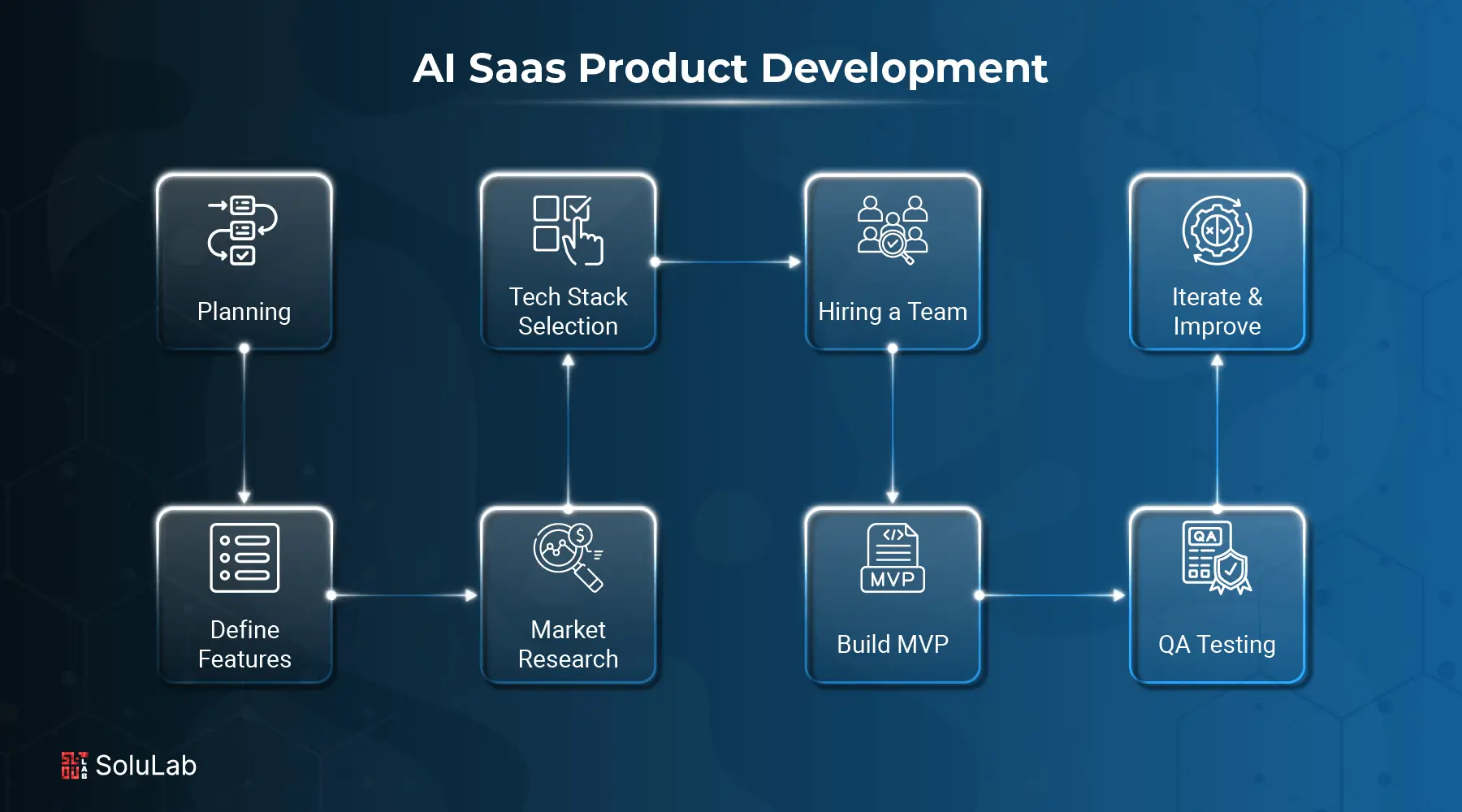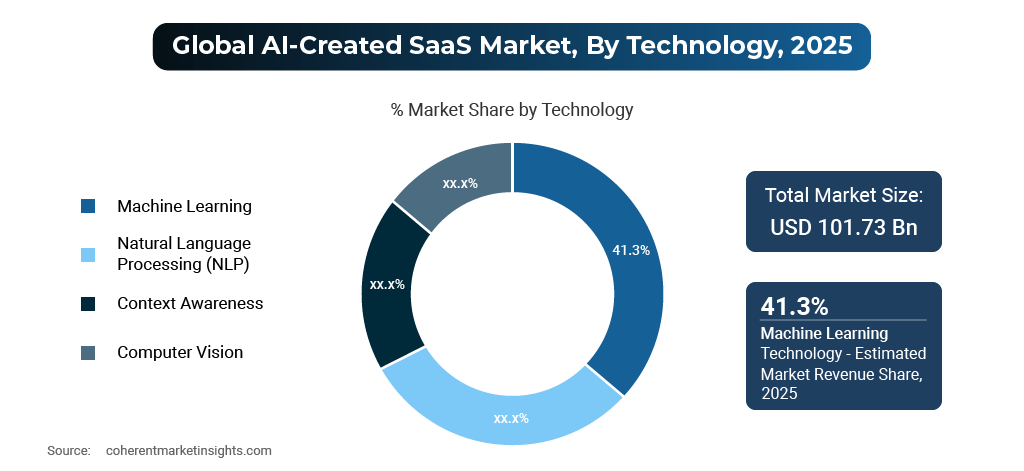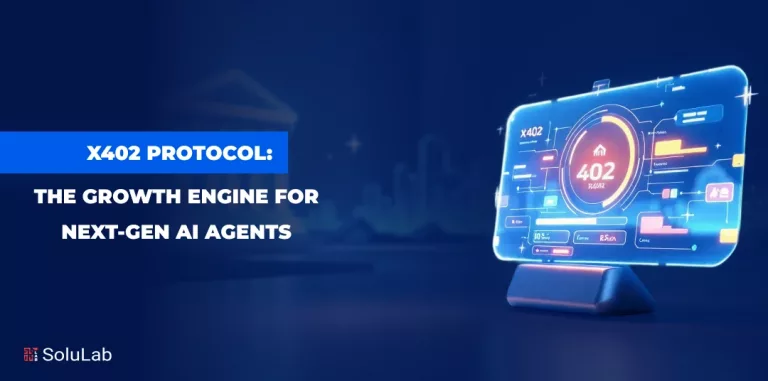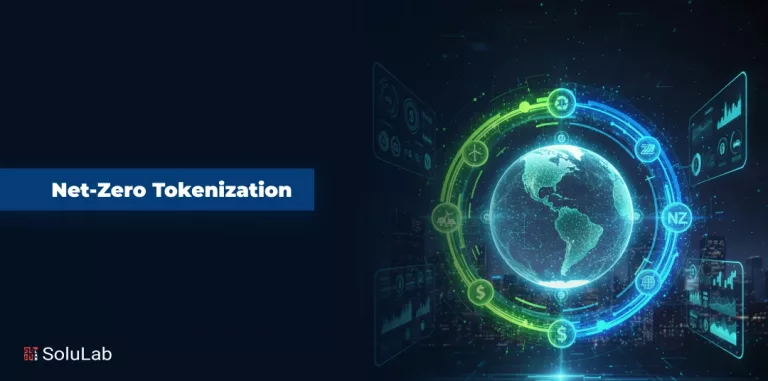
Many founders and product teams struggle to figure out where to start, what tools to use, or how to turn an AI idea into a real solution.
Though AI sounds fancy, without the right roadmap, it can lead to over-complication, high costs, and features no one needs. Plus, building a SaaS product already comes with challenges, and it adds another layer of complexity. If there’s no clear plan, using AI in product development often results in tools that confuse users rather than help them.
With the right strategy, tools, and team, AI can turn your SaaS product into something powerful. In this blog, we’ll walk you through the complete journey of developing an AI-powered SaaS product—from idea to MVP and beyond. Let’s break it down step by step!
Why is Artificial Intelligence & SaaS a Strong Combination?
According to Coherent Market Insights, from 2025 to 2032 AI Saas market will grow from $101.73 billion to $1.04 trillion, reflecting a 39.4% CAGR.

With the rise of generative AI SaaS development, we’re now seeing tools that don’t just automate tasks—they create content, generate insights, and even assist with decision-making in real time. Let’s break it down:
-
Enhanced Operational Efficiency
AI takes over the boring, repetitive stuff. This frees up SaaS providers to do what matters—innovate and grow. Less manual work, more creative problem-solving.
-
Data-Driven Personalization
AI watches how users interact and adapts. So instead of one-size-fits-all, SaaS platforms start feeling tailor-made. That keeps users engaged and sticking around.
-
Predictive Analytics
Want to know what’s coming next? AI aids in predictive analytics as it spots trends, improves workflows, and supports smarter decisions—all in real time.
-
Scalability & Cost Reduction
SaaS already scales well, but AI takes it up a notch. It helps manage resources wisely and cuts unnecessary costs. You grow without overspending.
-
Improved Customer Experience
Think AI-powered chatbots, smart automation, and smoother interactions. It’s like giving your customer service team a serious upgrade which is available 24/7.
-
Competitive Advantage
Using AI in your SaaS stack helps you stay sharp. You adapt faster, serve better, and stay ahead in your market.
How to Develop an AI-Powered SaaS Product?
Many AI SaaS companies find it difficult to build AI-powered tools. Developing an AI-powered SaaS product takes more than just coding—it’s about solving real problems with smart automation, thoughtful planning, and continuous iteration. Here’s how to get started.
1. Planning and Ideation
Start with a clear problem worth solving. Talk to potential users, study competitors, and identify market gaps. The goal is to ensure your product idea is both useful and feasible with AI. Map out how AI product development will add real value.
2. Define AI SaaS Features
Now, list out the must-have features. What tasks will AI handle—recommendations, predictions, automation? Define the core functionality, user experience, and expected outcomes. Keep it focused on solving pain points, not overloading users with unnecessary complexity.
3. Conducting the Discovery Phase
This is your research sprint. Validate assumptions, create user personas, and sketch out basic workflows. It’s about learning before building—understanding user behavior, technical risks, and business needs. The insights here guide the rest of your development journey.
4. Choosing the Tech Stack
Pick tools that support your goals. You’ll likely need a combination of cloud services, a strong backend framework, and machine learning libraries like TensorFlow or PyTorch. Think about scalability, speed, and how easily your stack supports AI integration.
5. Hiring a Team
You’ll need the right mix of talent—AI/ML engineers, SaaS developers, UI/UX designers, and a product manager. If hiring in-house is costly, consider hiring AI developers or some freelancers with proven experience in AI SaaS projects.
6. Building an MVP
Don’t aim for perfection—just build a working version of your core features. Focus on the unique value your AI brings. Keep the interface clean, and make sure users can test the main functionality without confusion.
7. Test for Quality Assurance
Now it’s time to find bugs, break features, and polish the experience. QA should cover performance, security, and edge cases. Also, test your AI models—accuracy, fairness, and reliability matter just as much as software stability.
8. Iterate and Improve
Launch, gather feedback, and refine fast. AI models especially need regular tuning as user data comes in. Use feedback loops to update features, fix issues, and fine-tune the product so it keeps delivering value over time.
Real World Examples of AI SaaS Product
Here are 5 real-world examples of AI-powered SaaS products, each with a short description and source:
- Fireflies.ai: Fireflies records, transcribes, and summarizes meetings using AI. It integrates with Zoom, Google Meet, and other tools. Fireflies review key insights and action items without relistening to entire calls.
- Grammarly: Grammarly uses AI to analyze text for grammar, tone, and clarity. It offers suggestions to improve writing and is used by professionals, students, and teams across SaaS platforms like email and Google Docs.
- Zendesk AI: Zendesk’s AI tools power automated ticket routing, chatbot support, and intent detection for customer service. It helps companies scale support without losing quality, using machine learning trained on billions of interactions.
- Notion AI: Notion AI helps users generate content, summarize notes, and rewrite drafts—all within the Notion workspace. It combines productivity with AI-powered creativity, improving everything from team planning to personal note-taking.
- Jasper: Jasper is an AI writing assistant for marketers and businesses. It creates ad copy, blog posts, and emails by learning brand voice and goals. It’s built on top of large language models like GPT-4.
How Much Does it Cost to Develop an AI SaaS Product?
Building an AI-powered SaaS product is not cheap. But it’s not out of reach either. The cost depends on the complexity of your idea, the size of your team, and the level of AI integration.
On average, a basic AI SaaS MVP can cost between $40,000 to $100,000.
If you’re outsourcing to a good development agency or hiring a remote team. For a more complex platform with custom AI models, expect costs to jump up to $150,000 or more. This includes research, design, development, AI model training, testing, and deployment as well.
Moreover, the breakdown looks like this: discovery and design take about 10–15% of the total cost. AI development and integration can take up 40–50%. The rest goes to backend/frontend development, QA, and post-launch support.
Read Also: How AI Integration Streamlines Operations for Small & Mid-Sized Companies?
Future of AI SaaS Product Development
As AI becomes more accessible, even smaller SaaS companies can now build smarter features like predictive analytics, chatbots, and personalized user experiences. Without needing massive data teams. Tools like OpenAI’s APIs, Google Vertex AI, and AWS SageMaker make it easier to plug AI into SaaS platforms.
Plus, with generative AI in the mix, SaaS products will soon go beyond automation—they’ll start creating content, code, reports, and insights on their own. Security and ethics will play a big role too, as users and regulators demand more transparency in how AI makes decisions.
AI won’t just support SaaS; it’ll shape how SaaS evolves. Smart, adaptive, and human-centered products will become the new normal.
Conclusion
So, we’ve explained everything about how to develop an AI SaaS product. An AI SaaS product has many advantages compared to traditional solutions. By combining the artificial intelligence with the flexibility of SaaS, businesses can deliver personalized experiences and stay competitive.
From ideation to launch, building an AI SaaS product requires planning, the right tech stack, and continuous improvement. As tools and platforms grow, even startups can tap into AI’s potential. SoluLab is a renowned name when it comes to top-notch AI development services. With our proven track record and high-tech prowess, we can cater to your business needs effectively.
Whether you’re solving niche problems or targeting broad markets, investing in AI-powered SaaS development sets you up for long-term innovation and growth. Recently, we got to work with such a tech-savvy client for developing an AI-powered recruitment platform, which rendered ultimate results.
SoluLab, a generative AI development company, can help you build the AI SaaS product plus give you expert insights to help you solve your queries. Contact us today to discuss further!
FAQs
1. What is an AI-powered SaaS product?
It’s a software-as-a-service tool that uses artificial intelligence to automate tasks, personalize experiences, and make smarter decisions without needing human input every time.
2. What industries are using AI SaaS solutions the most?
Healthcare, finance, e-commerce, HR, marketing, and customer support are leading the charge in using AI-powered SaaS tools.
3. Do I need a large dataset to build an AI SaaS product?
You can start with small, clean datasets and use pre-trained AI models or APIs from platforms like OpenAI, Google, or AWS. If you’re unsure where to begin, partnering with a generative AI development company can help you build smart features without the heavy data or infrastructure burden.
4. Can I integrate AI into an existing SaaS product?
You can layer AI features—like smart search, chatbots, or recommendations—on top of your current platform using APIs and SDKs. Many companies also offer AI product development services to help you integrate these features seamlessly without starting from scratch.
5. How do I protect user data in an AI SaaS app?
Use encryption, follow GDPR or Indian data privacy laws, and make sure your AI models don’t store or misuse sensitive data.
6. How to train an AI model on your SaaS product information?
Start by collecting clean, relevant user and product data. Use pre-trained models and fine-tune them on your datasets with tools like AWS SageMaker or Google Vertex AI. Keep retraining regularly to improve accuracy and adapt to changing user behavior.
7. Can generative AI help in SaaS product feature ideation?
Yes. Generative AI can analyze user feedback and market trends to suggest new features or improvements. It helps SaaS teams brainstorm, prototype, and validate feature ideas faster, turning insights into actionable concepts.






